Farmers in developing countries need resilient crop technologies
Gene-editing saves lives. So why are Western activists opposing it?
The European Union is rewriting its legislation on genetically modified organisms (GMOs) to distinguish between GMOs and newer gene-edited technologies known as New Genomic Techniques (NGT).
In its proposal to loosen EU legislation, The European Commission hopes to exempt plants that were produced using new genome-editing techniques from the current GMO restrictions. NGT crops have been found to reduce demand for pesticides and fertilisers, while also boosting the resilience of crops to climate change, pests, and diseases.
Gene-editing is a form of engineering in which genes can be deleted or added from the same or similar species, which leads to different outcomes for the new variety of plants. It is different from genetic modification (GMO technology), which involves introducing DNA from foreign species.
Currently, due to public distrust of gene-editing technology and intense lobbying from activist groups, only a handful of genetically modified organisms have been authorised in the EU, mainly for animal feed.
Since, under current legislation, all gene-edited and genetically modified plants fall under the blanket term of GMOs, this new technology, which can keep farmers afloat, their crops growing, and families fed, is being subject to unnecessary restrictions. The new plan proposes a category of plants that have used gene-editing (NGT), such as CRISPR-Cas9, to create new varieties of crops, such as tomatoes and potatoes that are resistant to fungus and therefore require less use of fungicide.
The draft proposal would exempt gene-edited plants from the current GMO law as long as they are equivalent to what could be accomplished with conventional plant breeding, which means that gene-edited plants that could not arise naturally would still require full GMO authorisation.
A battle is now raging over this proposed change.
The Hungarian government has responded to the new proposed legislation stating that it considers all genetically GMOs to be risky and will keep the country’s agriculture free of GMOs, which shows a fundamental misunderstanding of biotechnology and what the new proposals mean.
Slovakia is also against loosening the rules, confusing GMOs with NGT demonstrated by citing an “unchanging position on GMOs”. The Green Party and Greenpeace are also against the proposed new regulations.
Meanwhile, in Kenya, farmers have taken a step in the opposite direction and are turning to genetically modified crops (GMOs) to help them adapt to increasingly dry conditions and cope with drought. By lifting the ban on GMOs, Kenyan farmers can now openly cultivate GMO crops, as well as import food and animal feeds produced through genetic modification.
The Kenyan economy is heavily reliant on agriculture, with 80% of the rural population employed in some form of farm work. Maize is Kenya's staple food and is grown in 90% of all Kenyan farms, and it is used to prepare ugali, or maize meal, which is the country's most commonly eaten dish. Maize is also sensitive to temperature fluctuations, and therefore at risk due to global heating. A review of studies on GMOs found that over the past 20 years, the yield from GMO maize has improved.
Kenyan farmers rely on their crops both for income and to feed their families. Thanks to continuing droughts, Kenya is facing ongoing severe water shortages, which means failing crops and warnings of potential famine. After a ten-year ban on GMOs, Kenyan farmers are now putting their hopes in GMO technology to help turn the tide.
What are GMOs?

My real understanding of GMOs came from an unlikely source: an issue of National Geographic. I realised immediately that I had been misinformed into believing arguments made by the prominent anti-GMO activist Vandana Shiva, and my fellow environmentalists. In my environmentalist circles, Shiva was highly respected, even revered. In truth, none of our members understood what gene-editing was, which is not unusual, as research has found that the people who are most opposed to GMOs know the least about them.
Quite simply, the article explained that a genetically modified organism (GMO) is an animal, plant, or microbe whose DNA has been altered using genetic engineering techniques and that we have been using GMO technology for many decades. It simply isn’t the danger that anti-GMO activists make it out to be.
For thousands of years, humans have used breeding methods to modify organisms by crossing sexually compatible plants and then choosing what seemed like desirable characteristics (sturdy roots, for example, or disease resistance) from their offspring. Many foods and animals have been selectively bred to accumulate specific desired traits. Within the last few decades, modern advances in biotechnology have allowed scientists to also directly modify the DNA of microorganisms, crops, and animals, which means that we can now achieve desired traits without lengthy and wasteful breeding programs.
Now, almost all the plants we cultivate, including corn, wheat, rice, and even Christmas trees, have been genetically modified through breeding to last longer, look better, taste sweeter, or grow more vigorously in dry soil.
For a long time, anti-GMO activists have claimed that gene-edited foods aren’t safe to eat. But since 1996, when the crops were first planted, humans have consistently consumed genetically engineered foods and worn genetically engineered clothing, and there has not been a single case of illness as a result. The scientific consensus is that foods derived from genetically modified crops are as safe to eat as any other food.
So why do so many people feel that gene-editing techniques are bad, and where are their fears coming from?
Introducing Vandana Shiva
As an active member of the environmental movement in my 20s, I often heard good things about anti-GMO activist, Vandana Shiva.
In truth, like many environmentalists who did not know all of the details, I thought she was fighting a righteous battle. I had heard and read that she was taking down large and powerful corporations, who were – according to Shiva – manufacturing GMO seeds to force poor farmers to buy new seeds every year, instead of being able to save seeds from their current crops, amongst other terrible things.
Born in the city of Dehradun in Northern India to a government official and a school inspector, Vandana Shiva is one of the fortunate few Indians who was born into wealth. As a young adult, Shiva became active as an environmentalist and a feminist, and she founded the activist group Navdanya – meaning both ‘nine seeds’ and ‘new gift’ – a group that promotes organic farming, seed saving, ‘Earth democracy’ and other concepts, and organises protests against gene-edited crops.
Journalists have often portrayed Shiva as a hero, and she has won numerous environmental awards. In 2010, Shiva was awarded the Sydney Peace Prize for her commitment to social justice and her defence of the poor. Beloit College in Wisconsin honoured Shiva with its Weissberg Chair in International Studies, calling her “a one-woman movement for peace, sustainability, and social justice”. I had no reason to doubt that she was a hero. Her battle, of the small person against a monolith, fed into a wider narrative about who I believed to be the good guys and who were the bad.
Shiva also claims that the introduction of genetically modified cotton seeds in India has led to the mass genocide of poor farmers. Since my parents come from a family of rice farmers in the Punjab in India, I was shocked when I first heard this. Emboldened by Shiva’s arguments against the bag guys, I organised the first seed swap in my city, where we taught people about seed saving and encouraged them to exchange saved seeds rather than buying them, and to boycott large seed corporations.
The Exeter Seed Swaps were successful events, attended by hundreds of people. I felt like I was walking in Shiva’s footsteps: I was fighting ‘the man’ on a smaller scale. While I doubt handing out free seeds and encouraging people to grow plants was wrong, I now realise that believing misinformation about gene-editing technologies meant that I was treading a fine line.
The Green Revolution and the frank truth about ‘Frankenfoods’
Shiva is widely credited as being responsible for many arguments used by the anti-GMO crowd, although she is not alone in leading the movement – the pejorative term ‘Frankenfoods’ was coined by an American anti-GMO activist and Professor in 1992, who wrote “If they want to sell us Frankenfood, perhaps it's time to gather the villagers, light some torches and head to the castle."
Shiva also has a flair for the dramatic, which has captured imaginations all over the world, just as it had captured mine. For example, one of her arguments is that “The gradual spread of sterility in seeding plants would result in a global catastrophe that could eventually wipe out higher life forms, including humans, from the planet.” This is a frightening possibility, if true. However, I looked into the subject and discovered that although these so-called terminator genes were once a concept, they do not exist in the real world.
The Green Revolution was a period of technology transfer initiatives that saw greatly increased crop yields and agricultural production, through the adoption of newer methods of cultivation, including mechanisation. Over 60 years, modern crop varieties (MVs) of staple crops that had been developed by agriculture programs and international agricultural research centres spread across the developing world. MVs led to dramatic increases in crop yields, improving food supplies and triggering economic development in underdeveloped nations.
Yet Shiva claims that famine didn’t exist in India before the Green Revolution, and she blames MVs, fertilisers, pesticides, and machines for causing problems for Indian farmers (and mass suicides). History shows, however, that before the Green Revolution, starvation in India was common. Once modern agricultural techniques were employed during the Green Revolution, between 1965 and 1970, wheat yields nearly doubled in India and Pakistan.

If India had stuck to its traditional farming methods, millions of people would have starved. Research from MIT found that “In the year 2000, around 114 million children were born per year in the developing world, while the population-weighted average of crops planted to MVs was 63%. [T]his level of MV diffusion and associated Green Revolution technologies reduced the infant mortality rate by 2.4–5.3 percentage points, which translates into around 3–6 million infant deaths averted per year by the year 2000.”
Researchers have also concluded that “Africa's relative lack of a green revolution is often cited as a key reason for why the region has not yet experienced greater long-term economic success.”
Blind leading the literal blind: the story of Golden Rice
Shiva is heavily outspoken against Golden Rice, which is a form of normal white rice that has been genetically modified to provide vitamin A to counter blindness and other diseases in children in the developing world. Rice plants produce beta carotene, the precursor to vitamin A, in the leaves but not in the grain. To make Golden Rice, scientists insert genes in the edible part of the plant as well.
Lack of vitamin A is the world’s leading preventable cause of childhood blindness, especially common in Africa and South-East Asia. Every year, up to 500,000 children go blind due to vitamin A deficiency, and half of them die within 12 months of losing their sight. In many countries, including India, Bangladesh, and China, many children consume only rice daily, which means that this genetically modified rice could save millions of young lives from malnutrition, hunger and blindness.
A bowl of cooked Golden Rice can provide 60% of the recommended nutrient intake of vitamin A for children aged between 6 and 8. Just 20% of the recommended daily allowance can prevent or eliminate symptoms such as blindness.
Yet Shiva claims that “By focusing on only one crop, rice, which by itself does not provide all the nutrients, including higher quantities of Vitamin A than Golden Rice, the Golden Rice pushers are in fact worsening the crisis of hunger and malnutrition. Promoters of Golden Rice are blind to diversity, and hence are promoters of blindness, both metaphorically and nutritionally.”
Shiva’s alternate proposed solution to Golden Rice is a ‘diversity of diet,’ which is a nice idea, but the reason very poor people are suffering from blindness in the first place is because they cannot afford to buy vegetables or fruits, or cannot devote the land on their subsistence farms to grow more of these vegetables. In reality, converting a single crop will have an impact on millions of people much faster and easier than trying to implement and sustain a diversity of diets across very wide geographic areas.
Golden Rice was developed over 20 years ago, but it has not been readily adopted in the countries that most need it. This is because Golden Rice has been heavily opposed by anti-GMO activists, with Shiva leading the charge. In 2013, activists destroyed crops on an experimental field trial of Golden Rice in the Philippines. Greenpeace and Friends of the Earth have also played a major role in successfully demonising gene-editing technology and have successfully imported their anti-GMO campaigns to Asia and Africa.
In 2016, a third of living Nobel laureates including James Watson, who co-discovered the basic structure of DNA, signed an open letter to Greenpeace and world leaders, calling the NGO’s scare campaigns a “crime against humanity”. They wrote,
“Organizations opposed to modern plant breeding, with Greenpeace at their lead, have…have misrepresented their risks, benefits, and impacts, and supported the criminal destruction of approved field trials and research projects.
“We urge Greenpeace and its supporters to re-examine the experience of farmers and consumers worldwide with crops and foods improved through biotechnology, recognize the findings of authoritative scientific bodies and regulatory agencies, and abandon their campaign against "GMOs" in general and Golden Rice in particular.”
“Scientific and regulatory agencies around the world have repeatedly and consistently found crops and foods improved through biotechnology to be as safe as, if not safer than those derived from any other method of production. There has never been a single confirmed case of a negative health outcome for humans or animals from their consumption. Their environmental impacts have been shown repeatedly to be less damaging to the environment, and a boon to global biodiversity.”
A voice for farmers?
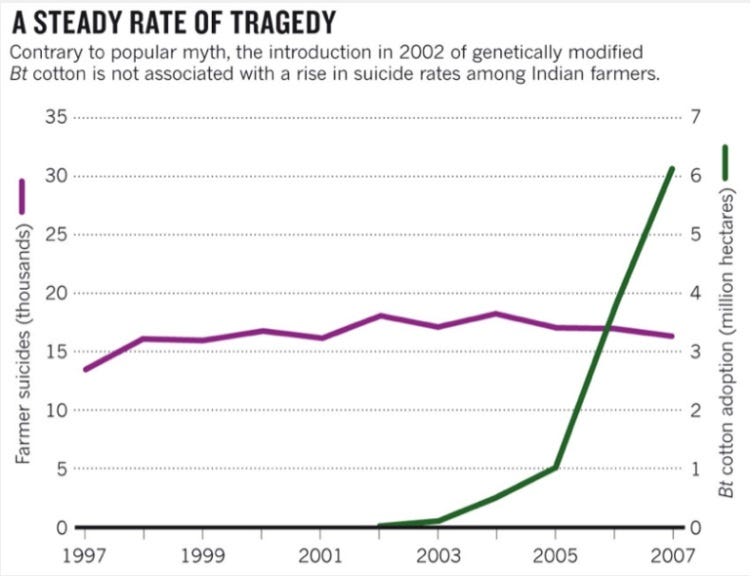
A common myth that Shiva has popularised is that Indian farmers commit suicide in huge numbers because of GMOs like Bt cotton, a genetically modified pest-resistant plant cotton variety that produces an insecticide to combat bollworm, a pest that damages cotton crops.
Bt cotton was introduced to India two decades ago to reduce farmers’ use of and exposure to insecticides. The scientific consensus of Bt cotton is that it has had a positive effect on cotton production, trade, farmers’ livelihoods, and the environment. According to one study, genetically modified crops have reduced chemical insecticide use by 37%, increased crop yields by 22% and increased farmer profits by 68%.
Although many Indian farmers do commit suicide, research has found that the suicide rate among Indian farmers has not been increasing as Shiva claims, and is lower than for other Indian people. It is also comparable to rates of suicide among French farmers. As horrific as India’s farmer suicide numbers may be, only about 10% of the total annual number of suicides in India are those of farmers.
One of the consequences of misinformation around GMOs in India is the decade-long delay of Bt brinjal (a variety of aubergine), a staple food crop in the country. Several NGOs in India have fiercely campaigned against Bt brinjal, and a moratorium on Bt brinjal remains in effect in India since 2010.
Seeds of change

Farmers have been fighting back. In 2019, the Indian farmers’ union Shetkari Sanghatana announced that it would illegally sow banned varieties of genetically modified seeds of Bt brinjal and Bt cotton in the Indian state of Maharashtra. This farmers’ association is opposed to the ban on GM crops, and around 5,000 people were expected to attend the pro-GMO protest.
President of Shetkari Sanghatana, Anil Ghanwat, told reporters: “Genetically modified seeds are being used all over the world and we have seen that the costs are less, pest attacks are fewer and the yields are higher. They are definitely much better for the farmer,” Ghanwat said.
A leaked draft of the EU legislation suggests that under the new rules, EU countries would no longer be able to ban the cultivation of NGT crops, which would benefit these farmers.
Earlier this year, pro-GMO activists and farmers marched through Nairobi in Kenya and Kampala in Uganda to protest GMO bans and call for the adoption of improved seed varieties to improve food security.
By blaming farmer suicides on Bt cotton, anti-GMO activists are distracting policymakers from the real problems Indian farmers face, and drowning out their voices. Instead, farmers need better financial and social service resources and some form of state-level safety net for when droughts cause crop failures. They also need to be able to decide for themselves what crops they grow, including gene-edited varieties.
Why have so many people been convinced by Vandana Shiva?
I hate to say it, but I think there’s some positive discrimination at play here. It’s not surprising to me that so many white, middle-class Westerners book Shiva to give talks for eye-watering sums. Nowhere is Shiva embraced more fully than in the West, where, as former White House Press Secretary Bill Moyers noted, she has become a “rock star in the worldwide battle against genetically modified seeds”.
There’s also something of the Indian persona of a ‘guru’ at play – and I write this as an Indian woman myself who has sometimes been deemed to be ‘mystical’ in some way (don’t you just love racial stereotyping?). Indeed, Shiva plays up to this stereotype: whereas when I travel, I go on a trip, Shiva goes on a ‘pilgrimage’. This Guardian article about Shiva opens with her saying “You don’t have to look very far to find the essence of life.”
Traditional environmentalists (who are typically white, Western, and middle-class) love to platform Shiva. She ticks their box for ‘diversity’ while holding the same views as them – there is no diversity of thought here.
The problem with box-ticking for diversity is that it reduces an individual to one characteristic, and few people can be categorised accurately this way. Shiva ticks the ‘brown’ and ‘Indian’ boxes, which has made her a powerful voice for Indian people to wealthy Westerners, who know little about what life is like for a rural Indian farmer. But Shiva is not a farmer nor from a farming background. She also does not represent diversity in terms of the Indian population. After all, most Indians are brown.
Unlike many Indians, Shiva has two post-graduate degrees. She comes from a wealthy, high-caste Brahmin family. Although India abolished the caste system in 1950, it is still at large in India, and wealth is concentrated among the upper classes.
India's caste system is a social structure that divides different groups into ranked categories. Members of ‘higher’ castes have a greater social status than ‘lower’ castes. The hierarchy consists of four main categories: those at the top are Brahmins – priests and teachers; then there are Kshatriyas – warriors and rulers; Vaishyas – traders and merchants; the Shudras – labourers, farmers, those doing the menial jobs; and at the bottom of the pile, and outside the categories, are the Dalits or ‘untouchables.’
Approximately 4.3 per cent of the total Indian population is considered to be a member of the Brahmin caste. When you consider this class divide, it is even more sickening that a wealthy Brahmin woman claims to speak for the lower castes, making arguments that are leading to their deaths. In reality, her campaigning actively harms the poorest Indian people.
Should a Brahmin be speaking for Shudras? I rather bluntly asked my father this once. He looked at me blankly. “What do they know about farming?” he asked. It’s a good question.
Shiva portrays the peasant farming lifestyle as a sacred stewardship of the land, rather than the back-breaking and stressful manual labour it is. In this manner, Shiva also speaks to Western fantasies of living-on-the-land ideology. I have come across this myself many times in the environmental movement: the idea that the Industrial Revolution was a mistake and we were all happier when living on land with minimal technology. The reality is that this way of life was brutal for humankind, where crushing poverty and high rates of infant mortality were the norm, before we developed machines to help us out.
Other countries want to escape this crushing poverty. Those that have been able to, have not managed to do so without embracing new technologies.
Sowing distrust
The story of anti-gene-editing gets worse: other vested interests have been found to have played a part in nefarious campaigns. Research by the Iowa State University found that some of the lies have been deliberate disinformation: the Russian television network Russia Today or Rossiya Segodnya (RT) and Russian propaganda outlet Sputnik have been prolific spreaders of falsehoods and scaremongering about transgenic organisms. As a result of this disinformation, Americans are split over the benefits of modern agricultural technology - and half of the country believes that GM crops are worse for one’s health than foodstuffs for which no genetic engineering was employed.
Writing in The Genetic Literacy Project, senior policy analyst Bill Wirtz reports:
“According to a letter sent to then-Treasury Secretary Steven Mnuchin by U.S. representatives Lamar Smith and Randy Weber, Hillary Clinton told a private audience in 2016, ‘We were even up against phony environmental groups, and I’m a big environmentalist, but these were funded by the Russians …’. Several elements point in this direction. WWF Germany, BUND (Friends of the Earth), and NABU (Nature and Biodiversity Conservation Union), three environmental organizations who were avowed opponents of Germany’s NordStream pipelines with Russia, dropped their opposition after Gazprom promised funding for environmental protection, according to information revealed in 2011. Representatives of European environmental organizations were board members of a multi-million dollar Gazprom-controlled foundation, raising questions about the political objectives of these organizations.
“The arrival of new agricultural technology presents the opportunities of addressing food safety, security, affordability, and sustainability. There are political and economic incentives for the Russian state to distort the scientific reality of those innovations, presenting major difficulties.”
Similar campaigns designed to undermine resilience in the West also link Russia to undermining clean energy initiatives, delivering a blow to energy independence alongside damaging crop resilience.
NGOs vs NGTS
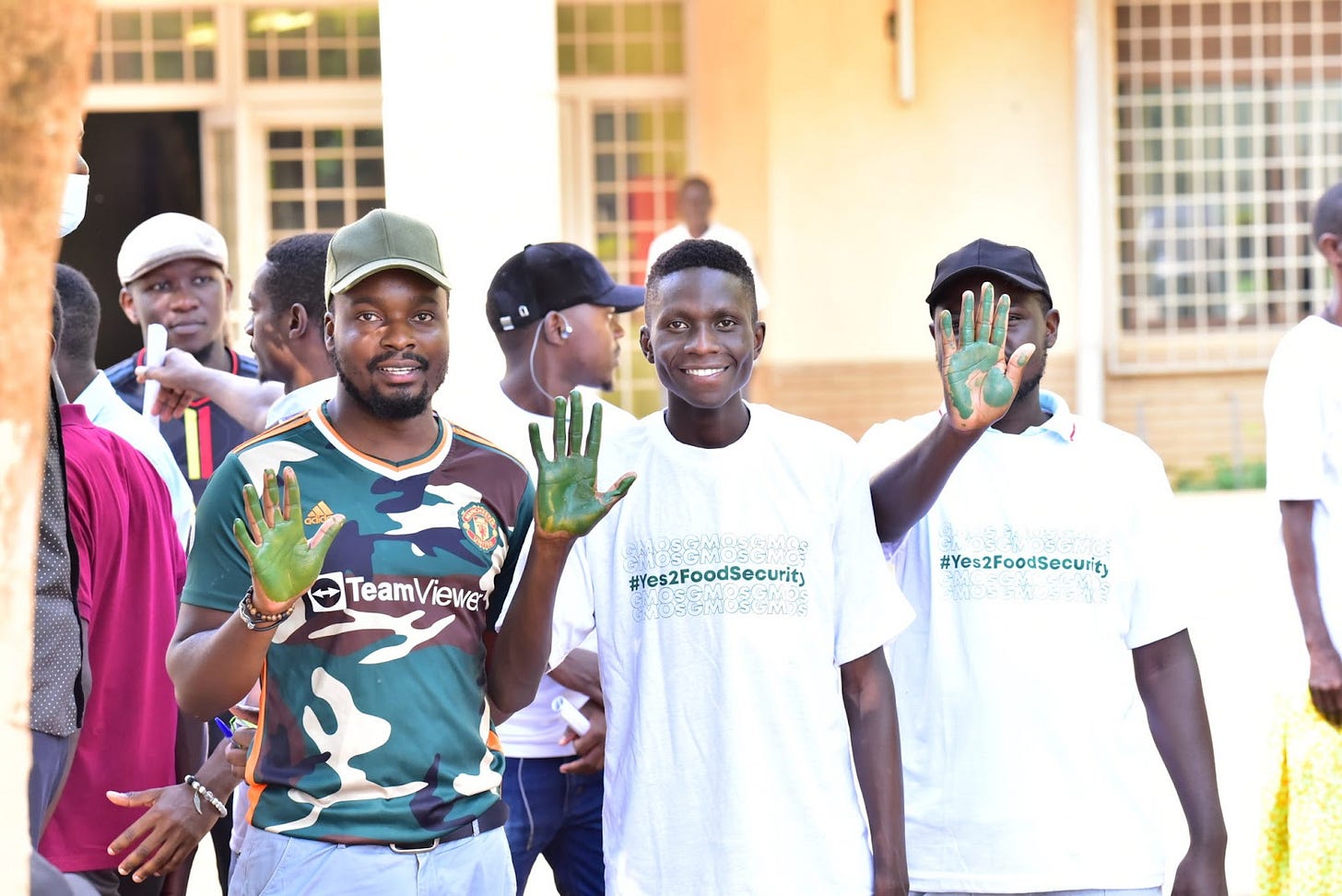
Vandana Shiva is widely celebrated as an “eco-warrior goddess,” but she spreads misinformation about gene-editing, campaigns against it and other solutions, and turns people against science and new scientific discoveries that can save millions of lives.
Humans have been altering agricultural plants for thousands of years. Relatively recent advances in gene-editing mean that plants can be more resistant to pests and diseases and withstand harsh environmental conditions. This is essential for farmers around the world who need to adapt to extreme weather and higher temperatures resulting from global warming, as well as feed a global population that is projected to reach 9 billion people in 2050.
Under current EU legislation, it is extremely difficult to get crops approved for cultivation, and the law allows EU countries to ban GMOs even when they have been proven to be safe, regardless of what farmers themselves want.
The tale of the potential and the restriction of gene-editing is similar to that of nuclear energy. Humans discovered a life-saving technology, but its application has been thwarted by misinformed activists and vested interests. Just as the EU recently included nuclear energy in its Sustainable Finance Taxonomy, the restrictions around gene-editing can now hopefully be relaxed.
Anti-technology activists are fighting back in both areas: on the gene-editing front, a Friends of the Earth petition has received 420,000 signatures, despite misinforming signatories that “claims on the supposed benefits for sustainability, pesticide reduction and climate” are “unsubstantiated”. I doubt many of the European signatories are poor farmers in developing countries.
Through drought and disease resistance, as well as increased resilience, NGT crops have the potential to fight starvation, malnutrition, blindness, poverty, and climate impacts in one stroke. If the anti-technology activists continue to win the battle against gene-edited crops, it will be yet another knock for science and human well-being.
We can only hope that in the instance of the proposed EU legislation of gene-editing, the decision-makers make the correct choice, so that farmers in developing countries are free to make use of technologies that will enable them to yield good harvests, even in a heating world. If misinformed anti-gene-editing sentiment continues to decide legislation, it is no exaggeration to call the actions of Shiva and her followers a crime against humanity. For the sake of farmers around the world, food security, and the thousands of children who are losing their eyesight daily, let’s hope the EU makes an informed choice that is based on foresight and evidence, rather than myopic activism.




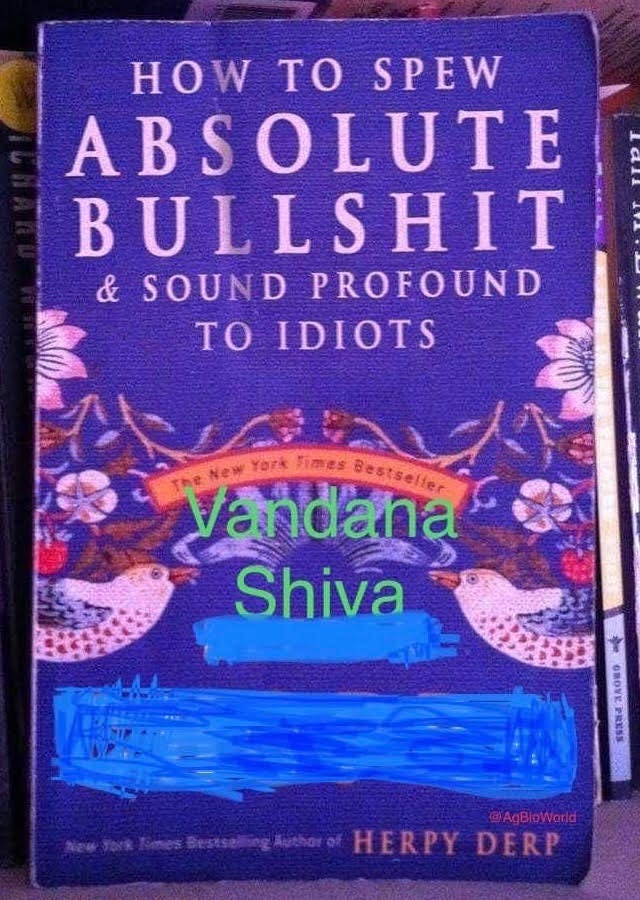

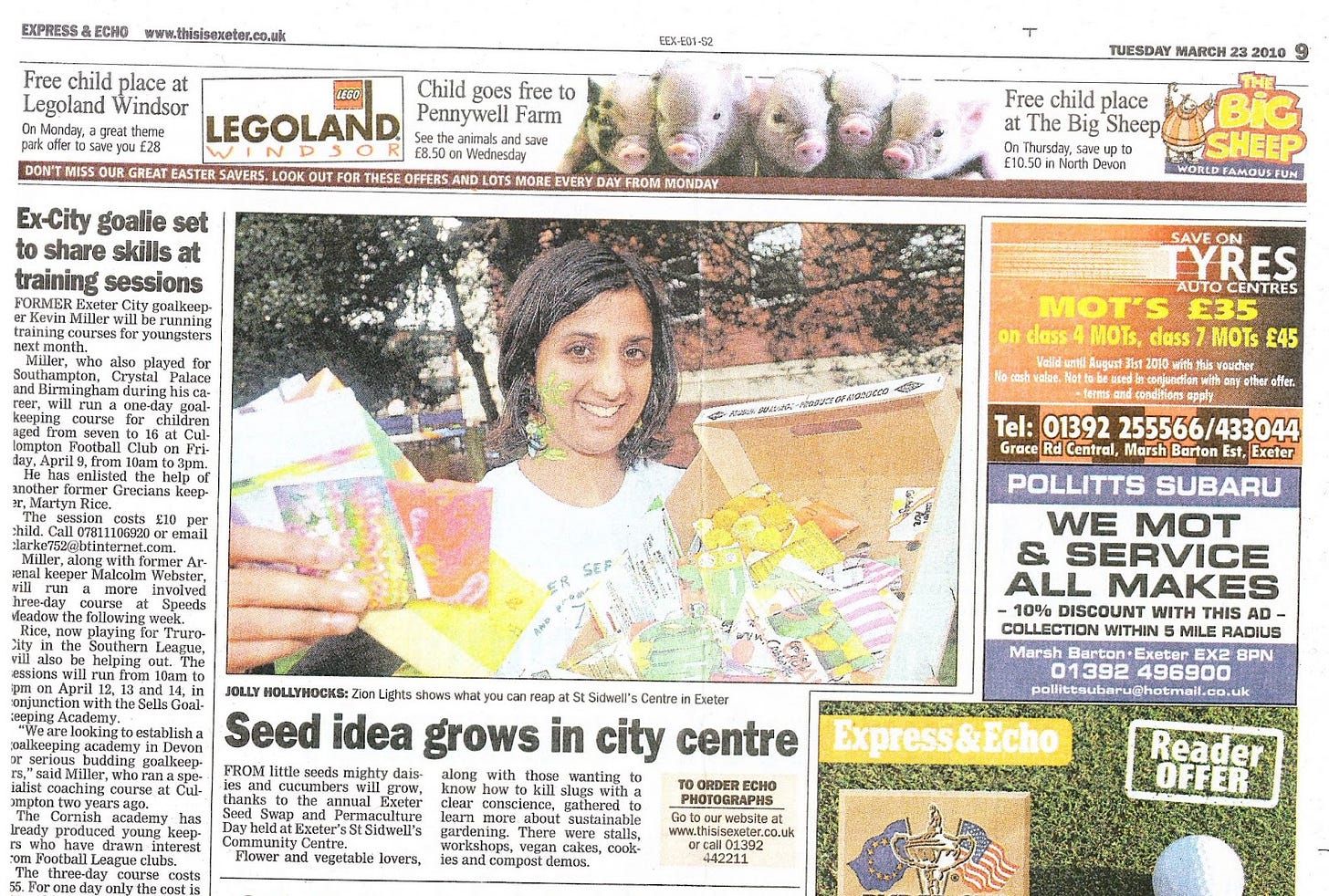
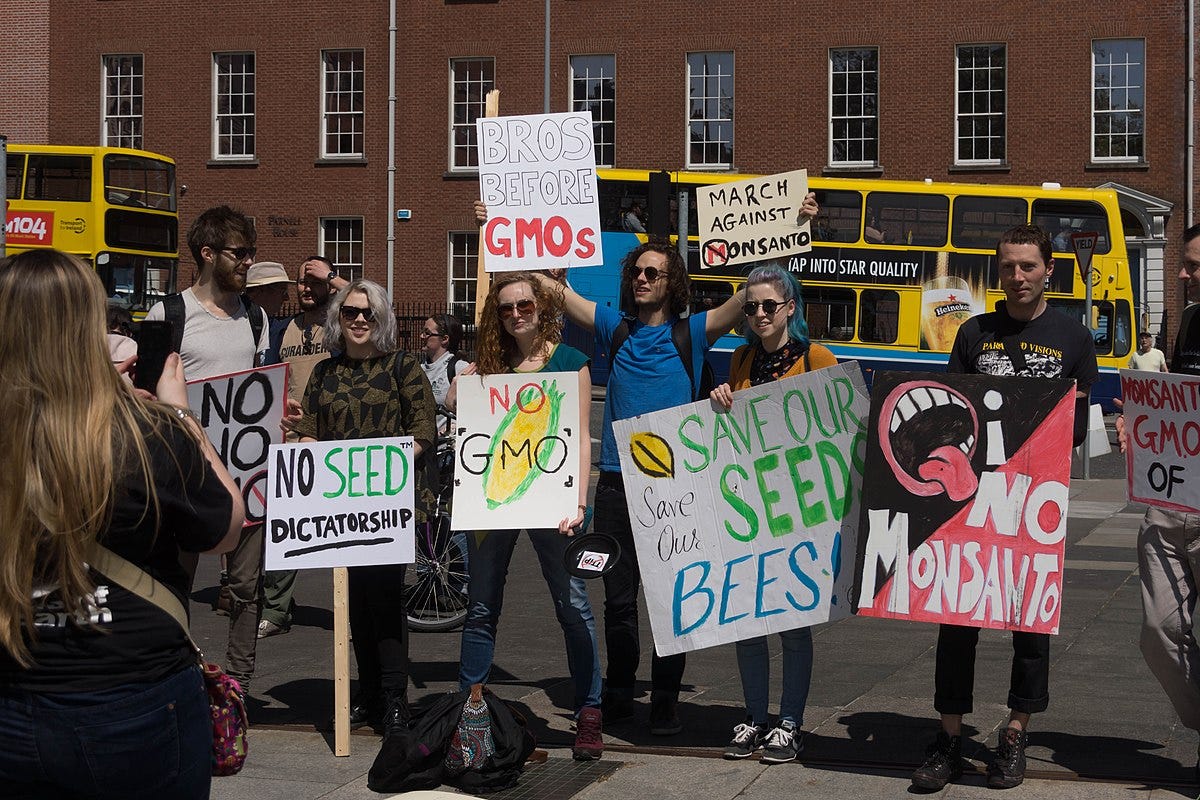
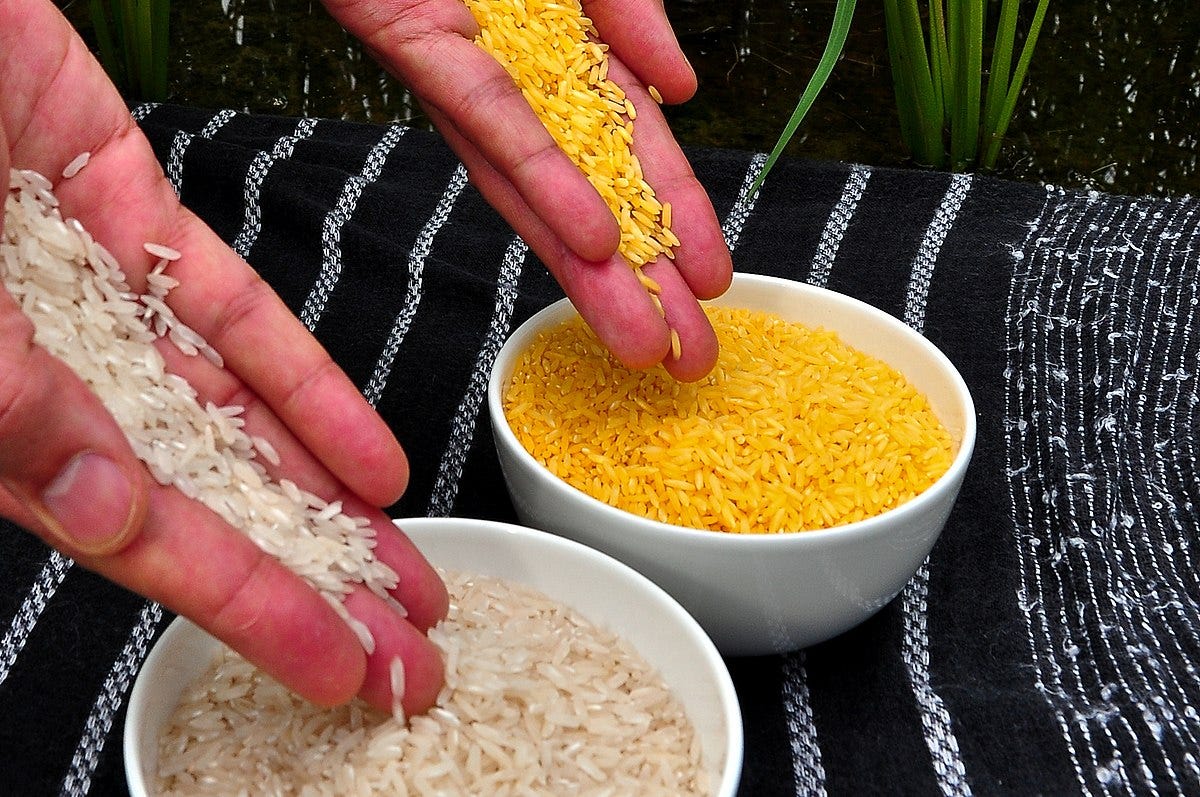
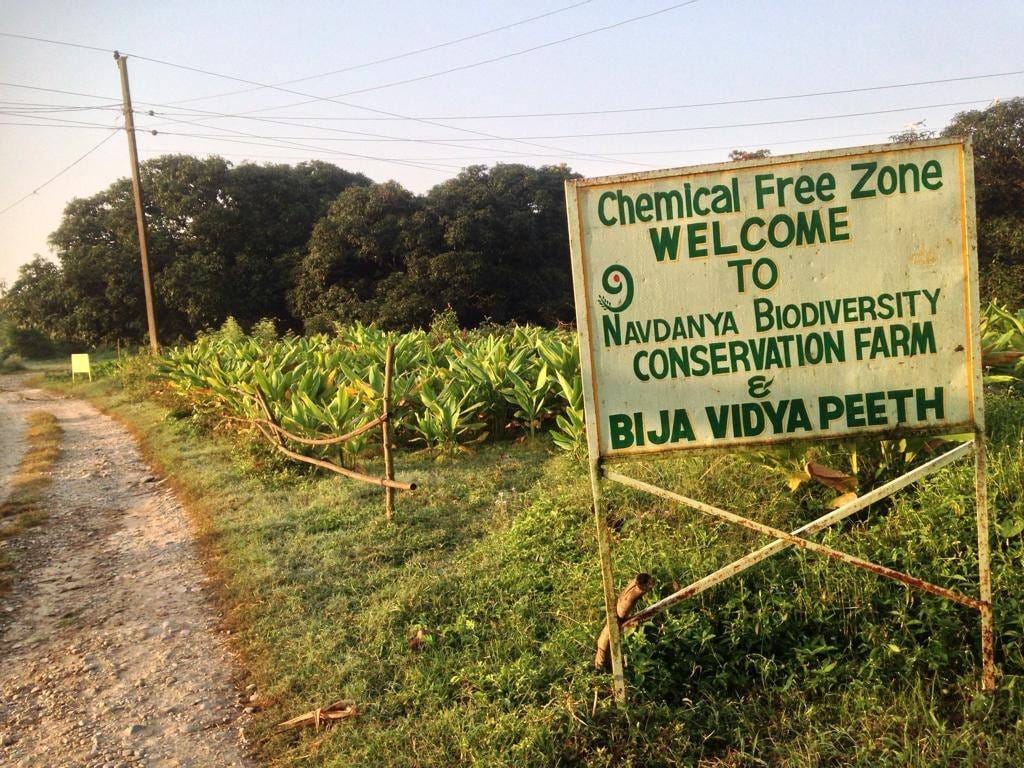
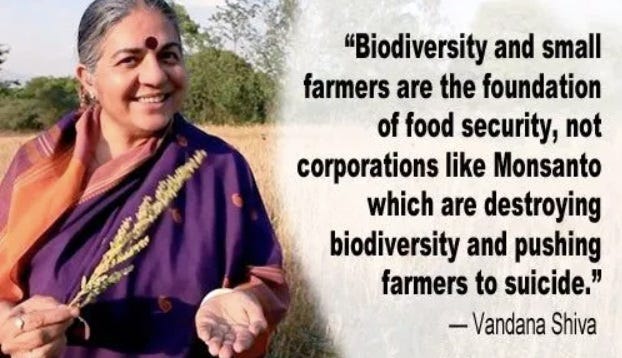
I love the way you think and write, and I greatly admire your ability to challenge the messaging of those who are widely perceived to be 'on the right side' in such critical matters as global food production!
Great article - a well-crafted fact-filled analysis - perfectly balanced should be picked up by mainstream media and widely disseminated.